National Bohemian Tapper (circa 1965)
This month let's go for size! It's a "tapper" can from Baltimore's National Bohemian.
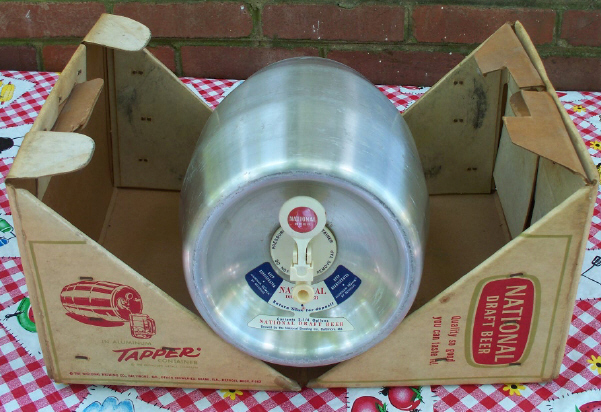 |
I've featured National Bohemian cans before. My December 2008 can was the Naty Boh "Colt" and my March 2007 can was their "transition" can from 1965. When National Brewing's Baltimore rival Gunther Brewing was bought out by Hamms in 1960 (see my October 2006 COM) it lost a lot of market share in Maryland, and National became the city's largest brewer. National Brewing had already begun an ambitious plan of expansion, which they continued into the 1960s, added a brewery in Arizona to those they already operated in Miami and Detroit in addition to their main facility in Baltimore. They also tried creating new brands, introducing Colt 45 Malt Liquor in late 1963 and canning their draft beer.
As part of this expansion into new markets and packaging, National looked for a way to promote the sale of draft beer into the home. National was not the only brewery interested in this potential market. Numerous breweries tried selling gallon cans in the 1960s and early 1970s.
Draft Beer
Before we get into National's new packages, however, what is it they were trying to sell? What is draft beer? Basically it is different from non-draft beer in how it is processed for sale. Beer that is bottled or canned is commonly pasteurized, that is, it is heated to killed unwanted bacteria. This increases shelf-life but will affect the beer's taste. As a brewer buddy told me, "it literally cooks the beer." Eventually filters were developed that had holes small enough to catch bacteria, and beer could be filtered cold and end up as "shelf stable" as pasteurized beer without having to cook it. Of course there were (and still are) assorted regulations governing whether or not a brewery could label their product as "draft." According to Industry Circular Number: 65-1, dated January 5, 1965 and released by the Office of the Commissioner of Internal Revenue Alcohol and Tobacco Tax Division
"The words 'keg' or 'draught' may be used as part of the designation of class and type for domestic products of the Brewing Industry in bottles, which are unpasteurized and which otherwise conform to the trade understanding of draught products."
In other words, for National and the other breweries trying the tapper, they could not just fill them with their same old beer and call it "draft." And to keep the beer at its best, they had to make sure that the tapper stayed cold, always an iffy thing to assume with shipping and retailers.
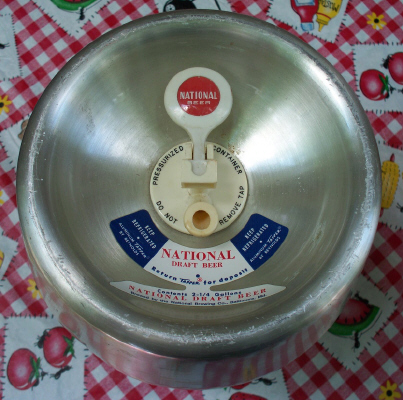 |
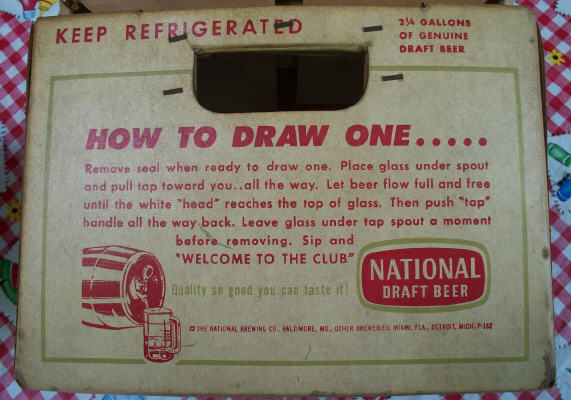 |
 |
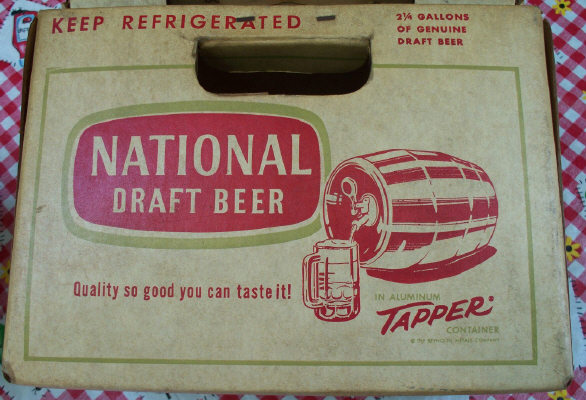 |
Some views of the National Tapper and its box, including instructions.
The Tapper and Reynolds
The Tapper was developed by Reynolds Aluminum. In about early 1963 (maybe late 1962) they tested it in 298 homes in Binghamton, New York. The company surveyed 2,500 homes to find those that were "medium to heavy beer consumers." The 298 test homes were given filled Tappers labeled only "Tapper: a famous brand of draft beer." (I do not know what brand of beer was actually in these test units.) Several days later the units were picked up and the customers interviewed. Reynolds was encouraged by the results. Most of the test families liked the Tapper, considered it a "space saver" in their refrigerators, and thought it worked well. It appeared that the Tapper was a feasible product, so next it had to be tested in the field under "market conditions" to see if it really would sell.
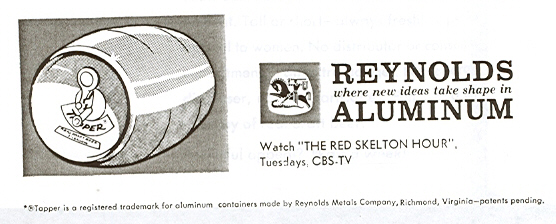 |
Reynolds Tapper ad, 1965.
The first companies to try it were Falstaff and Hamms. Falstaff tested it in Springfield, Illinois in May 1963. In July they added Fort Wayne, Indiana. By the end of the year Falstaff had expanded their Tapper test to ten towns, mostly in Indiana (Falstaff had a brewery in Fort Wayne). Hamms test marketed their Tapper in St. Cloud, Minnesota and Rockford, illinois. In the Fall of 1964 they began selling it nationally. At the end of 1964 National Brewing began selling the Tapper in Maryland. They also began selling their draft beer in a gallon can, testing it in Washington, DC, and several towns in Maryland, including Great Mills, White Plains, Cumberland, Hagerstown and Frederick.
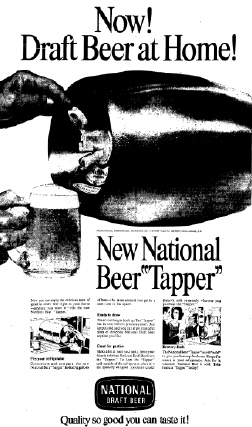 |
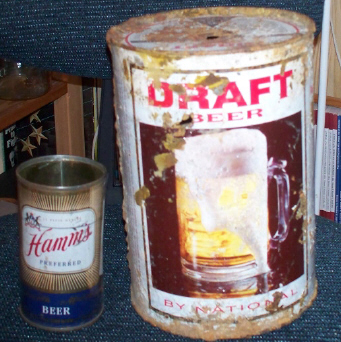 |
December 1964 National Brewing Ad. |
A dumper National Draft gallon (with a regular 12 oz can next to it for size comparison.) |
Reynolds proudly advertised the Tapper as a new way to, um, tap into the home market. They assured brewers that it would fit into 98% of home refrigerators. The Tappers were produced in Reynolds Louisville plant. By the end the Summer of 1965 four breweries were using them, Falstaff, Hamms, National and Ruppert of New York. I have also been told that Maier Brewing in California sold the Tapper with their mainstay, Brew 102.
Despite the optimism of Reynolds, the Tapper does not seem to have been a success. A friend who is old enough to remember told me that National Draft was in fact a good beer. However, from what I have been told, the beer would go flat in large cans (gallons or Tappers) if it was not consumed quickly. The original test market only left the Tappers with the consumers for a few days. Perhaps if they'd left them longer they would have learned about the beer going flat. I am not sure when the Tapper was pulled from the market, but the latest ads I found for it dated from late 1966.
Larger cans seemed to have been more successful in Europe. Called "Party Cans" in Britain, these larger cans generally ranged from approximately one US gallon to slightly smaller. They seem to have been marketed not as a way to have draft beer at home every day, but for special occasions, hence the "Party Can" name. In the 1990s some US brewers began to copy this strategy and gallon cans came back into fashion, although the 2.5 gallon Tapper never did.
Update: According to an email I received from a reporter that covered the beer business in the 1970s, Hamms and Falstaff used the cans at least as late as 1972 in the Chicago area. The marketing problem, according to Charles N., was not that the beer went flat, but that the Tapper was too bulky. The Tappers took up more retailer and distributor shelf space than the same amount of beer in regular cans, plus distributors had to set aside space and time to deal with the returned empties. In the end it was simply too much of a hassle.
Also, Charles noted, many home refrigerators of the time were also a bit too small to hold the Tapper without sacrificing space needed to other items. I remember having a pretty big refrigerator in the 70s, but my Dad was an engineer for Frigidaire and we got new appliances almost every year. After a year they'd go back to the factory to be taken apart and checked for wear. As a result we undoubtedly had better appliances than many other homes, so I'll go with Charles' explanation especially as those who still had refrigerators from the 50s and 60s would have had a smaller unit.
Tapper Stats
Contents: 2.5 gallons (equal to a case of 12 oz cans/bottles)
Weight: Full, 26 lbs, 5 oz.
Weight: Empty, 7 lbs, 10 oz.
The Tapper required a deposit and when it was empty the customer returned it to the store, either for their deposit or for a new one.
Value
The National Tapper is fairly common. You can usually find them at shows in their original "clam shell" box for about $20.00. The cans without the box usually go for about $10.00. Falstaff and Hamms Tappers are also common. I do not know how common the Brew 102 Tapper is. The Ruppert Tapper may be the hardest to find. I do not yet know if any other beers used the Tapper, but I am still looking.
As always, additions and corrections are welcome! Email me please!
Sources Used
Brewers Digest (July 1965)
"National Brewing Company Highlight" Beverage Journal (MD-DE-DC) (January 1965)
"Reynolds Aluminum Tapper" (advertisement) Brewers Digest (September 1965)
"The 'Tapper'" Brewers Digest (June 1963)
"Wrapper off the Tapper" Modern Brewery Age (September 1964)
Thanks to Matt and Charlie and several posters on the Rusty Bunch site. Thanks also to Charles N. for his email.
